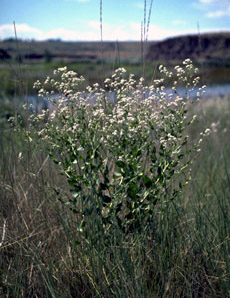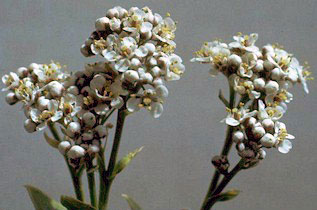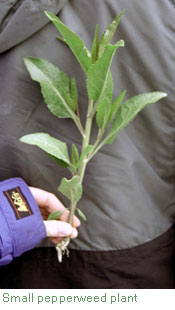Perennial pepperweed identification and control
Lepidium latifolium

Perennial pepperweed is most abundant along the Duwamish River on industrial lands. It is also found in patches on the Puget Sound shoreline and on the shores of Vashon Island.
Legal status in King County, Washington
This Class B noxious weed has a limited distribution, and control is required in King County. This species is also on the Washington quarantine list (known as the prohibited plants list) and it is prohibited to transport, buy, sell, offer for sale, or to distribute plants or plant parts, seeds in packets, blends or "wildflower mixes" of this species, into or within the state of Washington.
For more information on noxious weed regulations and definitions, see Noxious weed lists and laws.
Biology and morphology
Pepperweed generally grows 1 to 3 feet tall, but can reach up to 6 feet. It has many stems that emerge from a somewhat woody root crown with alternate, waxy leaves that have smooth or toothed margins and a prominent, whitish mid-vein. Basal leaves are lance-shaped and up to 12 inches long; they are attached by a stalk that can be almost as long as the leaf blade. Stem leaves are smaller, with shorter stalks. Perennial pepperweed's delicate, milky white flowers, which are sometimes collected for dry flower arrangement, grow in dense, rounded clusters at branch tips. Plants flower from June through September, producing small (1/16 inch) round or egg-shaped fruits. This plant spreads through profuse seed production and extensive, creeping roots. It has adapted to a wide range of habitats.
Additional information on perennial pepperweed
- King County Perennial Pepperweed Weed Alert (1.15 Mb)
- Washington State Noxious Weed Control Board (external link)
What to do if you find this plant in King County, Washington
Please notify us if you see perennial pepperweed growing in King County. Our program staff can provide the property owner or appropriate public agency with site-specific advice on how best to remove it. Also, because perennial pepperweed is not established in King County, we have an opportunity to stop it from spreading if we act quickly. We map all known locations of regulated noxious weeds such as perennial pepperweed in order to help us and others locate new infestations in time to control them.
Perennial pepperweed photos


Report perennial pepperweed in King County, Washington
- Please notify us through our online infestation form
Locate perennial pepperweed in King County, Washington
- Use our interactive noxious weed map and search
for perennial pepperweed
Related information
Related agencies
Program offices are located at 201 S. Jackson St., Suite 600, Seattle, WA 98104. To contact staff, see the Noxious Weed Control Program Directory, send an email, or call 206-477-WEED (206-477-9333).

 Translate
Translate